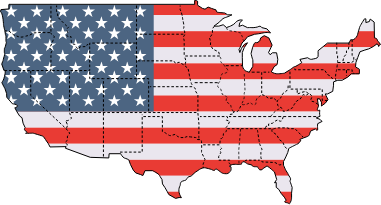- Opening Time : 8:30 AM - 9:30 PM

The United States of America, commonly known as the United States or America, is a country primarily located in North America. It consists of 50 states, a federal district, five major unincorporated territories, 326 Indian reservations, and some minor possessions. At 3.8 million square miles, it is the world’s third- or fourth-largest country by total area.
The United States of America, commonly known as the United States or America, is a country primarily located in North America. It consists of 50 states, a federal district, five major unincorporated territories, 326 Indian reservations, and some minor possessions. At 3.8 million square miles, it is the world’s third- or fourth-largest country by total are

American universities are widely known for the standard of their teaching and research. The USA is the favorite and largest destination for international students seeking Education overseas. The USA’s education system is the most versatile for international students worldwide.
Today about 30 percent of all international students are studying in the USA.
Have you ever wondered what makes U.S. education so popular in the world?
The U.S. has one of the world’s finest education systems, with excellent programs across all disciplines. At the undergraduate level, outstanding program options are available in conventional subjects and professional fields. At the Master’s and Ph.D. levels, students regularly get the chance to figure with and learn from some of the best researchers in the world. Qualifications awarded by U.S. universities are recognized throughout the planet for their academic brilliance.
The U.S. education system has lots to supply every student. The program structure emphasizes building a robust theoretical base alongside the importance of practical, employment-related skills. If you’re watching studying an unusual or specific program like gerontology, you’ll have quite one program to settle on from within the U.S.!
U.S. universities are world leaders in technology and scientific techniques and are committed to providing equivalent resources to students. The stress is to acquaint students with the newest in science, engineering, and related fields. The top result’s work-ready graduates with appropriate skills using the latest technology.
In the U.S., at the graduate level, students gain valuable experience in research and teaching through the various assistantship programs available. These assistantships also help students finance their Education in the USA. the practical experience gained is beneficial for future careers in teaching and research.
The U.S. education system offers many course choices within a program and, therefore, the opportunity to vary majors or choose multiple specializations. At the advanced stages of an undergraduate program, a student can tailor the program to satisfy specific career aspirations, like combining courses in contemporary jazz music with engineering! At the graduate level, you’ll make your timetable and complete course credits at a comfortable pace within the stipulated time frame.
U.S. universities welcome international students to pursue Education in the USA and have support systems to assist students in adjusting comfortably to life within the U.S. Services at the international student office help students transition to the new environment. Support is obtainable throughout the year, from organizing orientation programs to assisting with academic writing and building resumes as students prepare to graduate.
U.S. universities offer various choices of educational, cultural, and athletic activities to settle on, which not only enrich the tutorial experience but also help students make new friends and become global citizens. Your university can also have a cricket team, fraternities, and regional and ethnic clubs.
Academic study and knowledge from a U.S. university have a positive reputation within the international job market. A U.S. education dramatically enhances a student’s long-term career goals. The experience builds critical thinking skills and develops self-confidence and cross-cultural skills, and every one of those attributes is highly valued by employers worldwide.
The TOEFL requirement is often lower for a community college than for a four-year institution. In addition, the community college may still admit you into English as a Second Language (ESL) program if your TOEFL score is a little below the entry requirement. Completing all the prescribed ESL courses will open the door to the broader academic world of the community college. Many, but not all, colleges require international applicants to take an admissions test, usually the Scholastic Assessment Test (SAT I) or the American College Testing (ACT) Assessment.
Some may also require SAT II Subject Tests. Check ahead to determine specific test requirements. • The SATs are held several times per academic year, and registration materials are available from the test administrators or U.S. educational information and advising centers. You can also register on the World Wide Web.
The U.S. education system has lots to supply every student. The program structure emphasizes building a robust theoretical base alongside the importance of practical, employment-related skills. If you’re watching studying an unusual or specific program like gerontology, you’ll have quite one program to settle on from within the U.S.!
Every student is different, and when making your choices, you should consider the factors that are important to you in your education and lifestyle. Educational Information and Advising Centers U.S. educational information and advising centers can be found in almost every country worldwide, and they are the ideal starting point for your research. Some private educational consultants charge a fee for assisting you with choosing U.S. colleges and putting together your applications. Often these educational consultants and secret agents are graduates of U.S. colleges or people dedicated to promoting the benefits and advantages of the U.S. education system.
The United States doesn’t have a central office that approves educational institutions. Instead, it relies on a voluntary accreditation system administered by non-governmental accrediting bodies to ensure that schools meet standards. There is also no legal requirement that degree-offering institutions be accredited or hold specific accreditation. Due to this complexity, you ought to check carefully beforehand whether a degree from the institutions you’re applying to will be recognized by your home country’s government and any relevant professional associations, ministries, or employers in your country.
If you think that you would possibly wish to transfer from one U.S. college to a different one during your undergraduate studies, or if you would perhaps want to pursue graduate study within the USA, you ought to also check whether other U.S. universities will recognize credits and degrees from the universities you’re considering. U.S. educational information and advising centers can advise you regarding recognizing U.S. degrees in your country and tell you whether a U.S. degree-offering institution is appropriately accredited.
The USA has the world’s largest international student population, with nearly 600,000 students choosing to broaden their education and life experience within the USA. Almost 4% of all students enrolled in higher-level education are international, and the numbers are growing. From the mid-1950s, when international student enrollment barely reached 35,000, international education within the USA has extended.
If you’re getting to live, learn and grow within the USA, you already possess a well-known American characteristic—a sense of adventure! As a world student, you’ll experience many new and exciting things. During this section, we hope to organize you for a few of the adventures involved in living within the USA.
It is difficult, if not impossible, to debate precisely what “Living within the U.S.” means to everyone. American culture has been enriched by the values and belief systems of virtually every part of the planet. From a world student’s perspective, that diversity is precious. If you select to measure during a completely different environment, you’ll be challenged with new situations every day. Still, if you measure a part of the U.S. that resembles your home country in some ways, you’ll find comfort in those similarities.
Learning more about yourself is the foremost important part of your decision to visit the U.S. Once you recognize what you would like to realize, you’ll identify the proper place to review, live, and grow within the States.
As you’ll know, one of the hallmarks of U.S. culture is independence. Here is a little advice written by non-U.S. students a bit like you! To form friends, you want to take the initiative to satisfy people. Due to the American value of independence, Americans will only sometimes be searching for you or ensuring that you are becoming familiar with people. They assume you’re taking care of yourself unless you tell them differently. If you do not invite help, Americans will think you do not need anything. So remember—ask for help once you need it!
In some cultures, it’s polite to refuse two or three times if someone offers something to you. But within the U.S., it’s polite to answer “Yes, please” if you’d like what’s being offered. Many exciting situations arise when a non-U.S. student who is hungry or thirsty refuses the offer of food or drink, thinking this is polite behavior. But when no second or third offer was made, there was no chance to mention yes.
Contrary to the stereotype of independence and individuality, most Americans are conformists and gain their identity by belonging to groups. You’ll notice that many students join groups to both get familiar with others and satisfy a requirement to belong. You’ll be surprised at what percentage of students look alike on your campus, with similar hairstyles and clothing.
Americans sometimes find it challenging to work out, so keep an open mind and obtain to understand them as individuals.
This is a list of selected cities, towns, and other populated places in the United States, ordered alphabetically by state.

University, institution of higher education, usually comprising a college of liberal arts and sciences and graduate and professionals. The short story shut a final door and other tales of loveless.
| SL | Name of Universities | Ranking |
|---|---|---|
| 01 | Harvard Universitu | 01 |
| 02 | Johns Hopkins University | 02 |
| 03 | California Institute of Technology - Caltech | 03 |
| 04 | Princeton University | 04 |
| 05 | University of California, Berkeley | 05 |
| 06 | Yale University | 06 |
| 07 | Massachusetts Institute of Technology (MIT) | 07 |
| 08 | University of Chicago | 08 |
| 09 | University of Pennsylvania | 09 |
| 10 | Stanford University | 10 |